Abstract
Data obtained in lizards infected with live bacteria suggest that fever may be beneficial to their survival. An adaptive value of fever has also been inferred in mammals, but the results are equivocal. Findings that certain leukocyte functions are enhanced in vitro at high temperatures have provided a possible explanation for the alleged benefits of fever. However, serious questions exist as to whether results from experiments in ectotherms and in vitro can properly be extrapolated to in vivo endothermic conditions. Indeed, various studies have yielded results inconsistent with the survival benefits attributed to fever, and fever is not an obligatory feature of all infections under all conditions. Certainly, the widespread use of antipyretics, without apparent adverse effects on the course of disease, argues against fever having great benefit to the host. In sum, although fever is a cardinal manifestation of infection, conclusive evidence that it has survival value in mammals is still lacking.
Full text
PDF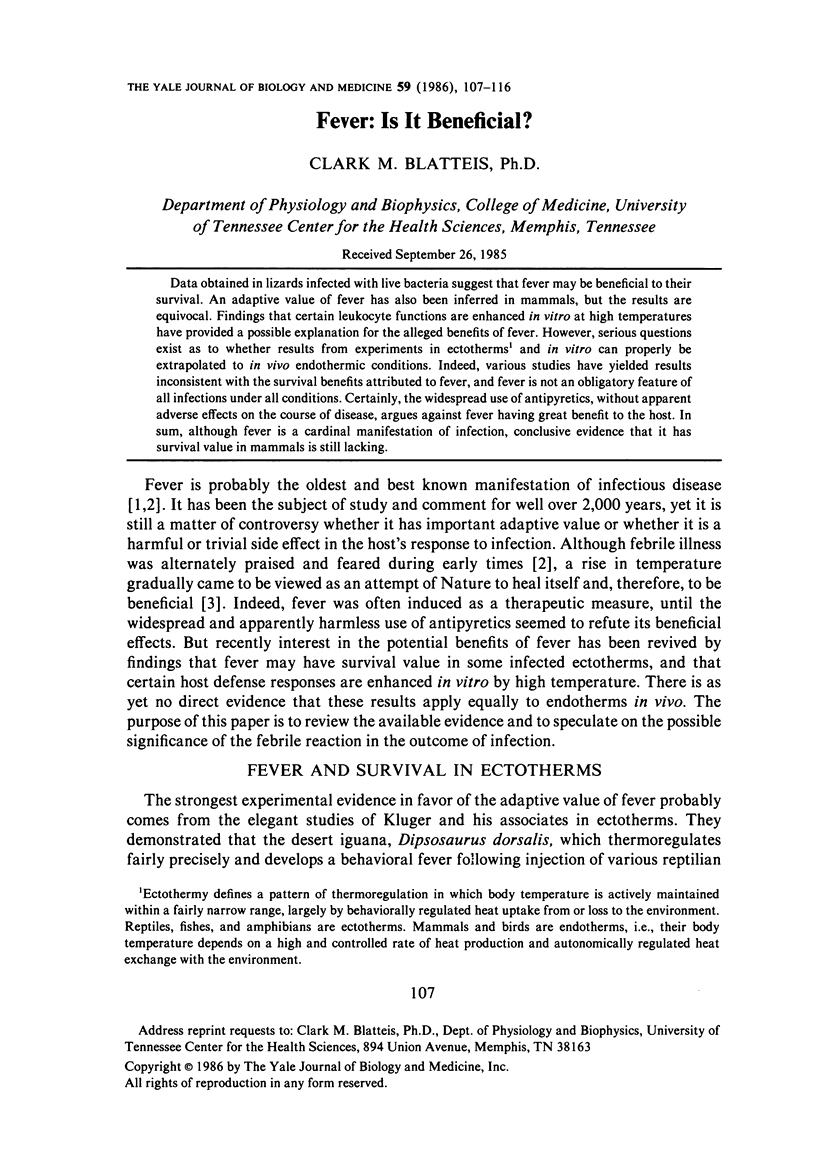
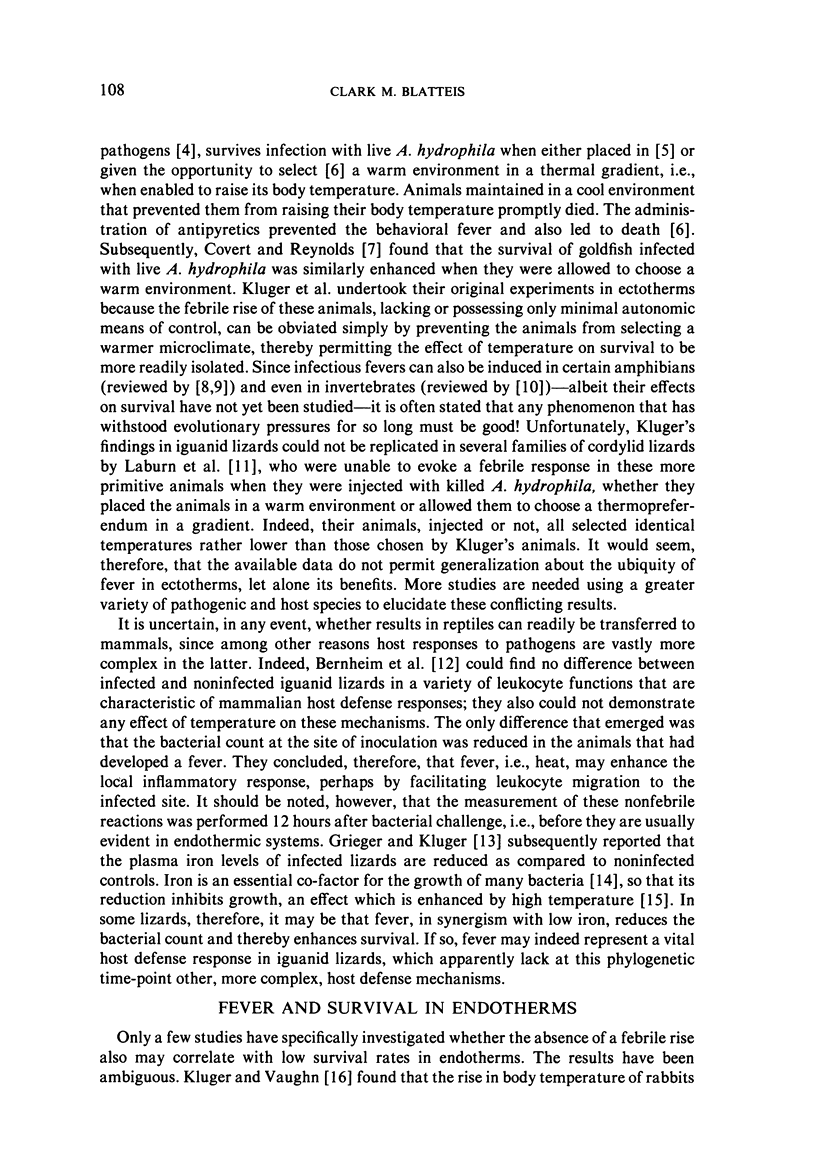
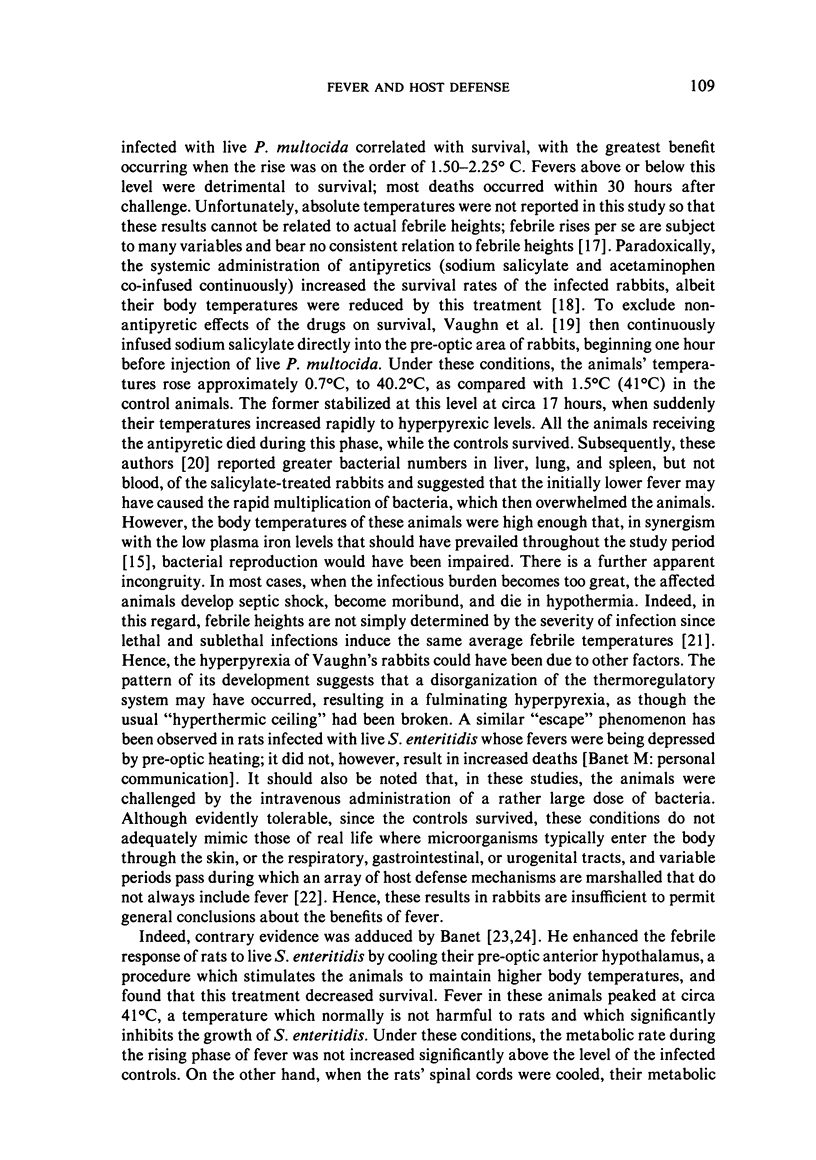
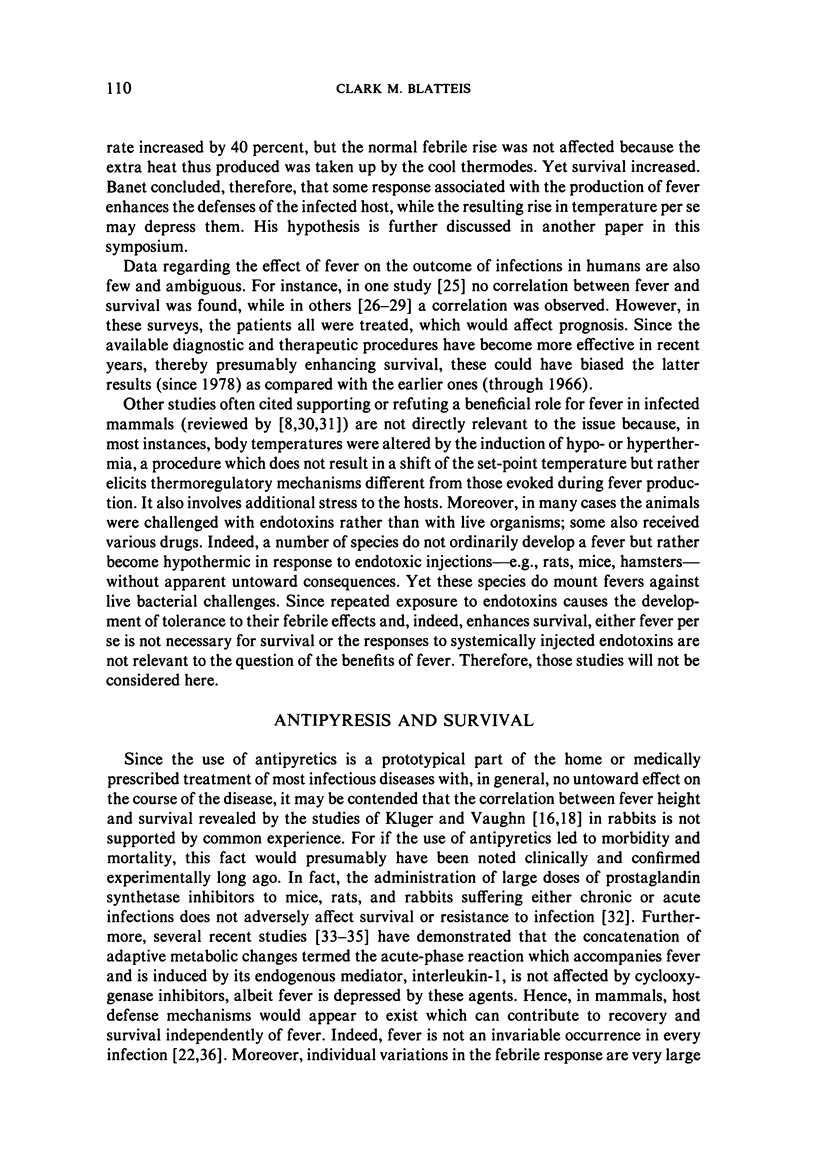
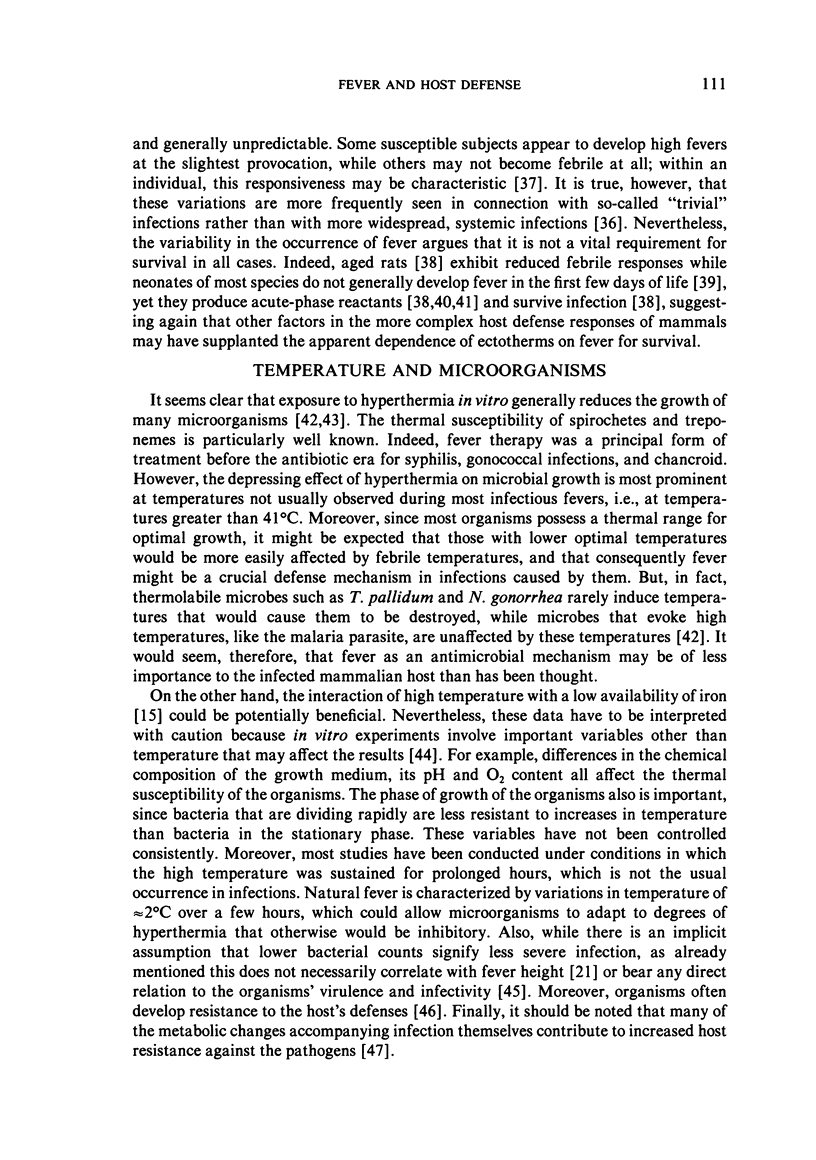
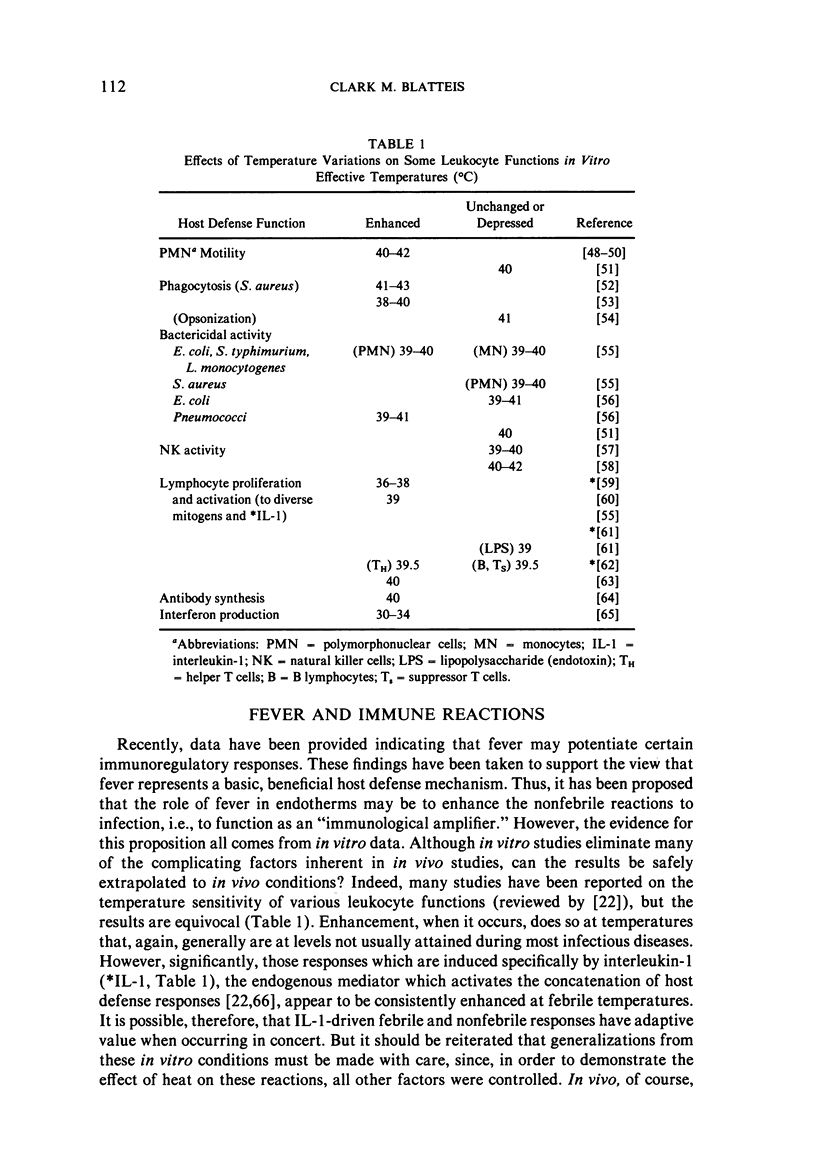
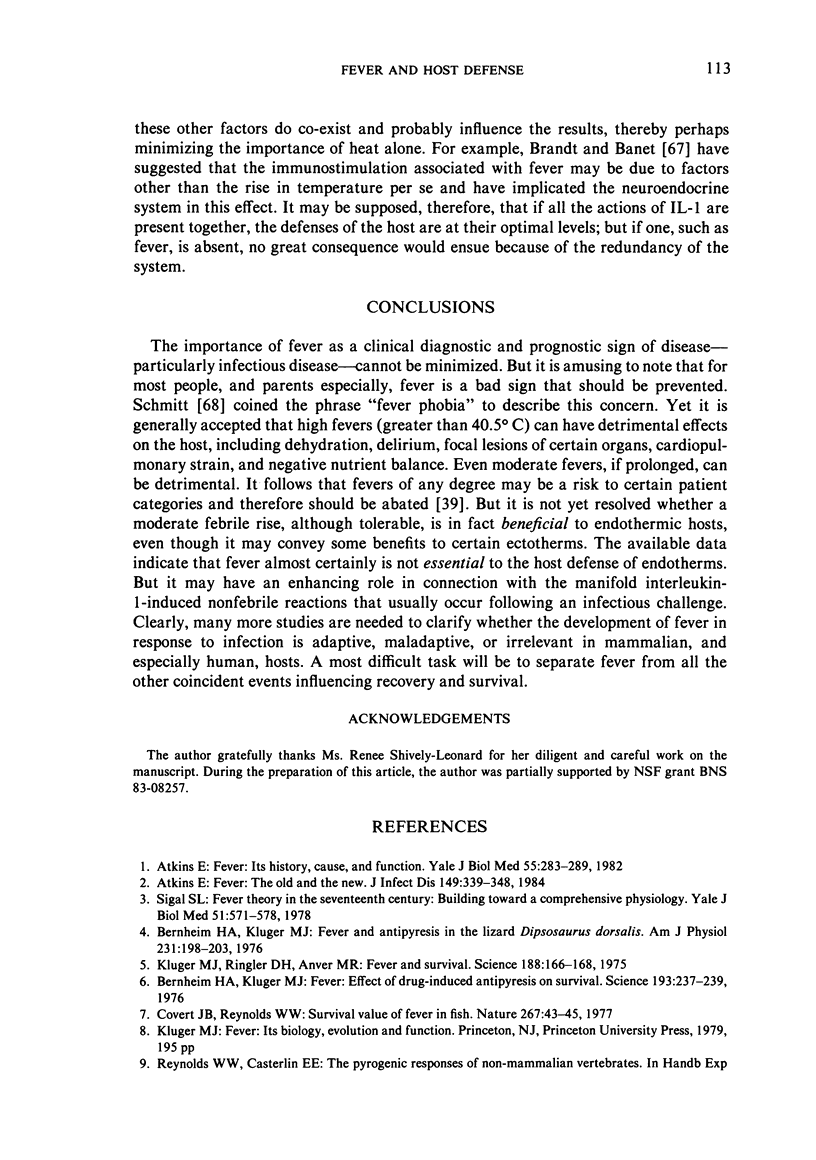
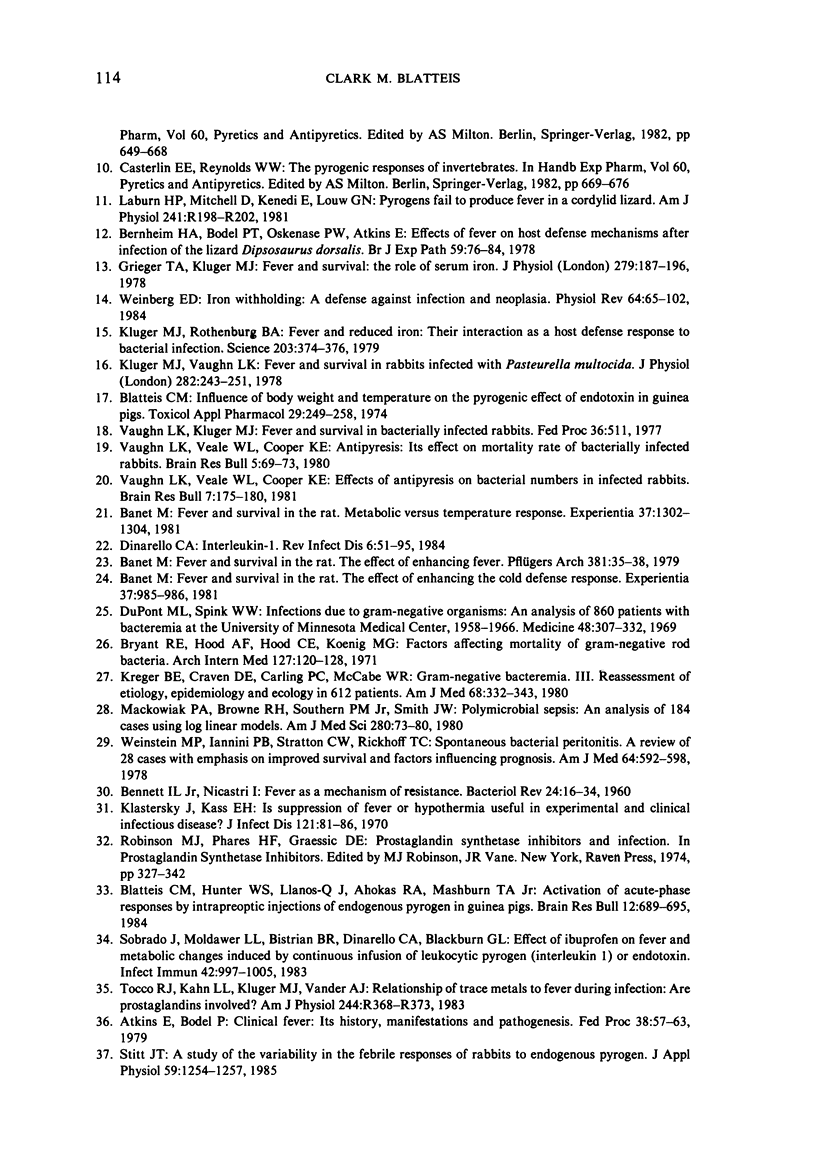
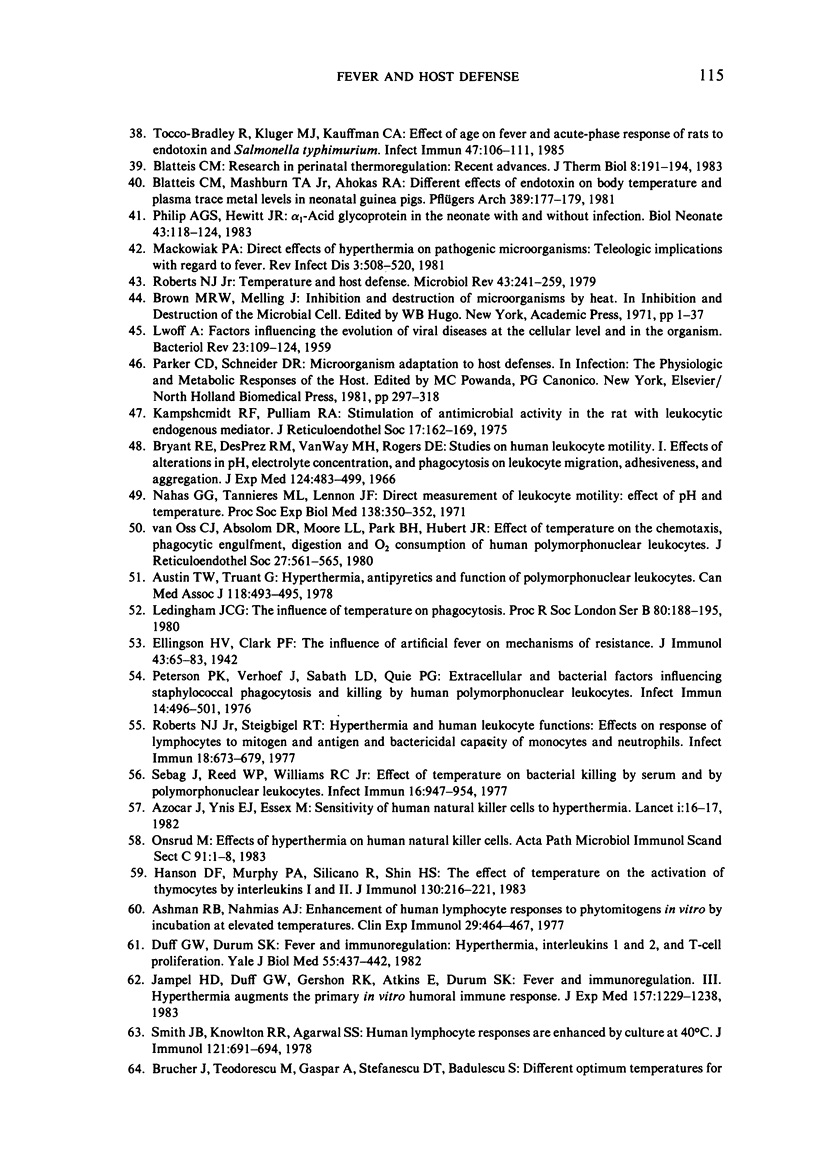
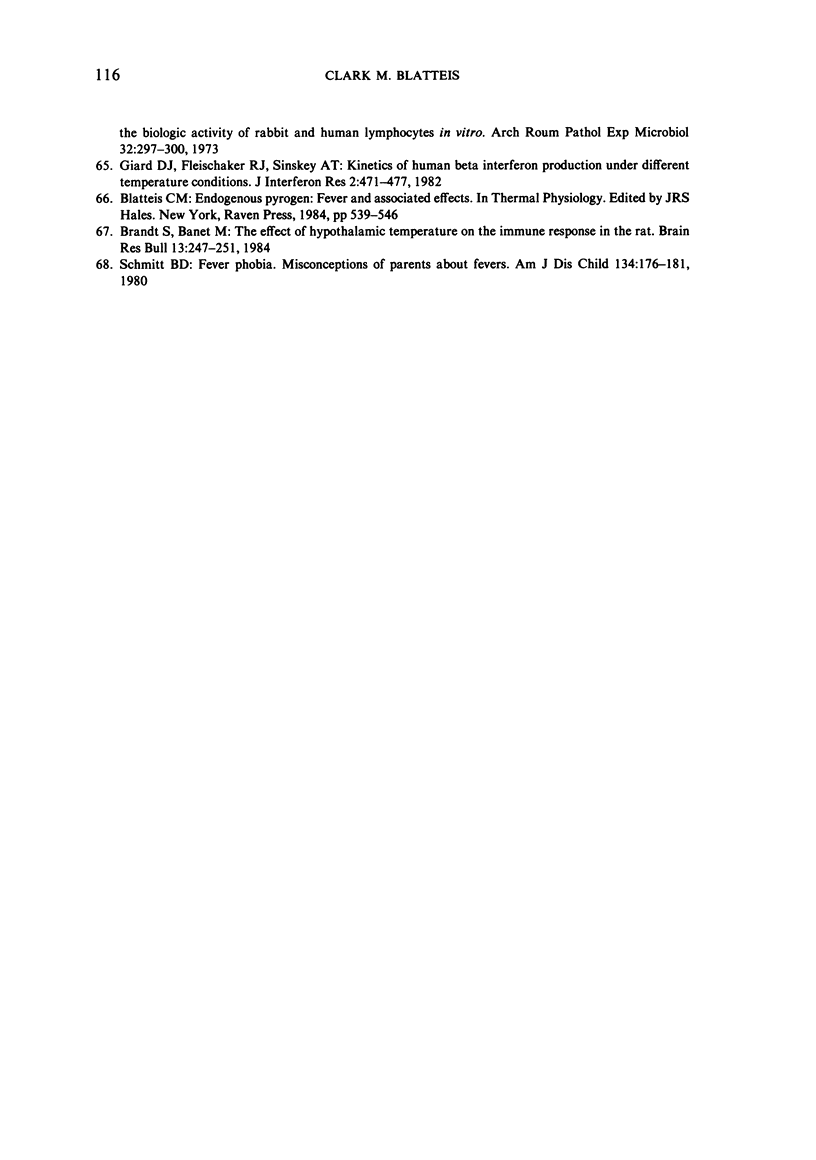
Selected References
These references are in PubMed. This may not be the complete list of references from this article.
- Ashman R. B., Nahmias A. J. Enhancement of human lymphocyte responses to phytomitogens in vitro by incubation at elevated temperatures. Clin Exp Immunol. 1977 Sep;29(3):464–467. [PMC free article] [PubMed] [Google Scholar]
- Atkins E., Bodel P. Clinical fever: its history, manifestations and pathogenesis. Fed Proc. 1979 Jan;38(1):57–63. [PubMed] [Google Scholar]
- Atkins E. Fever: its history, cause, and function. Yale J Biol Med. 1982 May-Aug;55(3-4):283–289. [PMC free article] [PubMed] [Google Scholar]
- Atkins E. Fever: the old and the new. J Infect Dis. 1984 Mar;149(3):339–348. doi: 10.1093/infdis/149.3.339. [DOI] [PubMed] [Google Scholar]
- Austin T. W., Truant G. Hyperthermia, antipyretics and function of polymorphonuclear leukocytes. Can Med Assoc J. 1978 Mar 4;118(5):493–495. [PMC free article] [PubMed] [Google Scholar]
- Azocar J., Yunis E. J., Essex M. Sensitivity of human natural killer cells to hyperthermia. Lancet. 1982 Jan 2;1(8262):16–17. doi: 10.1016/s0140-6736(82)92558-2. [DOI] [PubMed] [Google Scholar]
- BENNETT I. L., Jr, NICASTRI A. Fever as a mechanism of resistance. Bacteriol Rev. 1960 Mar;24(1):16–34. doi: 10.1128/br.24.1.16-34.1960. [DOI] [PMC free article] [PubMed] [Google Scholar]
- Banet M. Fever and survival in the rat. Metabolic versus temperature response. Experientia. 1981 Dec 15;37(12):1302–1304. doi: 10.1007/BF01948375. [DOI] [PubMed] [Google Scholar]
- Banet M. Fever and survival in the rat. The effect of enhancing fever. Pflugers Arch. 1979 Jul;381(1):35–38. doi: 10.1007/BF00582329. [DOI] [PubMed] [Google Scholar]
- Banet M. Fever and survival in the rat. The effect of enhancing the cold defence response. Experientia. 1981;37(9):985–986. doi: 10.1007/BF01971794. [DOI] [PubMed] [Google Scholar]
- Bernheim H. A., Bodel P. T., Askenase P. W., Atkins E. Effects of fever on host defense mechanisms after infection in the lizard Dipsosaurus dorsalis. Br J Exp Pathol. 1978 Feb;59(1):76–84. [PMC free article] [PubMed] [Google Scholar]
- Bernheim H. A., Kluger M. J. Fever and antipyresis in the lizard Dipsosaurus dorsalis. Am J Physiol. 1976 Jul;231(1):198–203. doi: 10.1152/ajplegacy.1976.231.1.198. [DOI] [PubMed] [Google Scholar]
- Bernheim H. A., Kluger M. J. Fever: effect of drug-induced antipyresis on survival. Science. 1976 Jul 16;193(4249):237–239. doi: 10.1126/science.935867. [DOI] [PubMed] [Google Scholar]
- Blatteis C. M., Hunter W. S., Llanos J., Ahokas R. A., Mashburn T. A., Jr Activation of acute-phase responses by intrapreoptic injections of endogenous pyrogen in guinea pigs. Brain Res Bull. 1984 Jun;12(6):689–695. doi: 10.1016/0361-9230(84)90149-7. [DOI] [PubMed] [Google Scholar]
- Blatteis C. M. Influence of body weight and temperature on the pyrogenic effect of endotoxin in guinea pigs. Toxicol Appl Pharmacol. 1974 Aug;29(2):249–258. doi: 10.1016/0041-008x(74)90062-3. [DOI] [PubMed] [Google Scholar]
- Blatteis C. M., Mashburn T. A., Jr, Ahokas R. A. Fever and trace metal changes in endotoxin-challenged neonates. Pflugers Arch. 1981 Jan;389(2):177–179. doi: 10.1007/BF00582111. [DOI] [PubMed] [Google Scholar]
- Brandt S., Banet M. The effect of hypothalamic temperature on the immune response in the rat. Brain Res Bull. 1984 Aug;13(2):247–251. doi: 10.1016/0361-9230(84)90124-2. [DOI] [PubMed] [Google Scholar]
- Brucher J., Teodorescu M., Gaşpar A., Stefănescu D. T., Bădulescu S. Different optimal temperatures for the biologic activity of rabbit and human lymphocytes in vitro. Arch Roum Pathol Exp Microbiol. 1973 Jun;32(2):297–300. [PubMed] [Google Scholar]
- Bryant R. E., DesPrez R. M., VanWay M. H., Rogers D. E. Studies on human leukocyte motility. I. Effects of alterations in pH, electrolyte concentration, and phagocytosis on leukocyte migration, adhesiveness, and aggregation. J Exp Med. 1966 Sep 1;124(3):483–499. doi: 10.1084/jem.124.3.483. [DOI] [PMC free article] [PubMed] [Google Scholar]
- Bryant R. E., Hood A. F., Hood C. E., Koenig M. G. Factors affecting mortality of gram-negative rod bacteremia. Arch Intern Med. 1971 Jan;127(1):120–128. [PubMed] [Google Scholar]
- Covert J. B., Reynolds W. W. Survival value of fever in fish. Nature. 1977 May 5;267(5606):43–45. doi: 10.1038/267043a0. [DOI] [PubMed] [Google Scholar]
- Dinarello C. A. Interleukin-1. Rev Infect Dis. 1984 Jan-Feb;6(1):51–95. doi: 10.1093/clinids/6.1.51. [DOI] [PubMed] [Google Scholar]
- DuPont H. L., Spink W. W. Infections due to gram-negative organisms: an analysis of 860 patients with bacteremia at the University of Minnesota Medical Center, 1958-1966. Medicine (Baltimore) 1969 Jul;48(4):307–332. doi: 10.1097/00005792-196907000-00003. [DOI] [PubMed] [Google Scholar]
- Duff G. W., Durum S. K. Fever and immunoregulation: hyperthermia, interleukins 1 and 2, and T-cell proliferation. Yale J Biol Med. 1982 Sep-Dec;55(5-6):437–442. [PMC free article] [PubMed] [Google Scholar]
- Giard D. J., Fleischaker R. J., Sinskey A. J. Kinetics of human beta interferon production under different temperature conditions. J Interferon Res. 1982;2(4):471–477. doi: 10.1089/jir.1982.2.471. [DOI] [PubMed] [Google Scholar]
- Grieger T. A., Kluger M. J. Fever and survival: the role of serum iron. J Physiol. 1978 Jun;279:187–196. doi: 10.1113/jphysiol.1978.sp012339. [DOI] [PMC free article] [PubMed] [Google Scholar]
- Hanson D. F., Murphy P. A., Silicano R., Shin H. S. The effect of temperature on the activation of thymocytes by interleukins I and II. J Immunol. 1983 Jan;130(1):216–221. [PubMed] [Google Scholar]
- Jampel H. D., Duff G. W., Gershon R. K., Atkins E., Durum S. K. Fever and immunoregulation. III. Hyperthermia augments the primary in vitro humoral immune response. J Exp Med. 1983 Apr 1;157(4):1229–1238. doi: 10.1084/jem.157.4.1229. [DOI] [PMC free article] [PubMed] [Google Scholar]
- Kampschmidt R. F., Pulliam L. A. Stimulation of antimicrobial activity in the rat with leukocytic endogenous mediator. J Reticuloendothel Soc. 1975 Mar;17(3):162–169. [PubMed] [Google Scholar]
- Klastersky J., Kass E. H. Is suppression of fever or hypothermia useful in experimental and clinical infectious diseases? J Infect Dis. 1970 Jan;121(1):81–86. doi: 10.1093/infdis/121.1.81. [DOI] [PubMed] [Google Scholar]
- Kluger M. J., Ringler D. H., Anver M. R. Fever and survival. Science. 1975 Apr 11;188(4184):166–168. [PubMed] [Google Scholar]
- Kluger M. J., Rothenburg B. A. Fever and reduced iron: their interaction as a host defense response to bacterial infection. Science. 1979 Jan 26;203(4378):374–376. doi: 10.1126/science.760197. [DOI] [PubMed] [Google Scholar]
- Kluger M. J., Vaughn L. K. Fever and survival in rabbits infected with Pasteurella multocida. J Physiol. 1978 Sep;282:243–251. doi: 10.1113/jphysiol.1978.sp012460. [DOI] [PMC free article] [PubMed] [Google Scholar]
- Kreger B. E., Craven D. E., Carling P. C., McCabe W. R. Gram-negative bacteremia. III. Reassessment of etiology, epidemiology and ecology in 612 patients. Am J Med. 1980 Mar;68(3):332–343. doi: 10.1016/0002-9343(80)90101-1. [DOI] [PubMed] [Google Scholar]
- LWOFF A. Factors influencing the evolution of viral diseases at the cellular level and in the organism. Bacteriol Rev. 1959 Sep;23(3):109–124. doi: 10.1128/br.23.3.109-124.1959. [DOI] [PMC free article] [PubMed] [Google Scholar]
- Laburn H. P., Mitchell D., Kenedi E., Louw G. N. Pyrogens fail to produce fever in a cordylid lizard. Am J Physiol. 1981 Sep;241(3):R198–R202. doi: 10.1152/ajpregu.1981.241.3.R198. [DOI] [PubMed] [Google Scholar]
- Mackowiak P. A., Browne R. H., Southern P. M., Jr, Smith J. W. Polymicrobial sepsis: an analysis of 184 cases using log linear models. Am J Med Sci. 1980 Sep-Oct;280(2):73–80. doi: 10.1097/00000441-198009000-00002. [DOI] [PubMed] [Google Scholar]
- Mackowiak P. A. Direct effects of hyperthermia on pathogenic microorganisms: Teleologic implications with regard to fever. Rev Infect Dis. 1981 May-Jun;3(3):508–520. doi: 10.1093/clinids/3.3.508. [DOI] [PubMed] [Google Scholar]
- Nahas G. G., Tannieres M. L., Lennon J. F. Direct measurement of leukocyte motility: effects of pH and temperature. Proc Soc Exp Biol Med. 1971 Oct;138(1):350–352. doi: 10.3181/00379727-138-35894. [DOI] [PubMed] [Google Scholar]
- Peterson P. K., Verhoef J., Sabath L. D., Quie P. G. Extracellular and bacterial factors influencing staphylococcal phagocytosis and killing by human polymorphonuclear leukocytes. Infect Immun. 1976 Aug;14(2):496–501. doi: 10.1128/iai.14.2.496-501.1976. [DOI] [PMC free article] [PubMed] [Google Scholar]
- Philip A. G., Hewitt J. R. Alpha 1-acid glycoprotein in the neonate with and without infection. Biol Neonate. 1983;43(3-4):118–124. doi: 10.1159/000241618. [DOI] [PubMed] [Google Scholar]
- Roberts N. J., Jr, Steigbigel R. T. Hyperthermia and human leukocyte functions: effects on response of lymphocytes to mitogen and antigen and bactericidal capacity of monocytes and neutrophils. Infect Immun. 1977 Dec;18(3):673–679. doi: 10.1128/iai.18.3.673-679.1977. [DOI] [PMC free article] [PubMed] [Google Scholar]
- Roberts N. J., Jr Temperature and host defense. Microbiol Rev. 1979 Jun;43(2):241–259. doi: 10.1128/mr.43.2.241-259.1979. [DOI] [PMC free article] [PubMed] [Google Scholar]
- Schmitt B. D. Fever phobia: misconceptions of parents about fevers. Am J Dis Child. 1980 Feb;134(2):176–181. [PubMed] [Google Scholar]
- Sebag J., Reed W. P., Williams R. C., Jr Effect of temperature on bacterial killing by serum and by polymorphonuclear leukocytes. Infect Immun. 1977 Jun;16(3):947–954. doi: 10.1128/iai.16.3.947-954.1977. [DOI] [PMC free article] [PubMed] [Google Scholar]
- Sigal S. L. Fever theory in the seventeenth century: building toward a comprehensive physiology. Yale J Biol Med. 1978 Sep-Oct;51(5):571–582. [PMC free article] [PubMed] [Google Scholar]
- Smith J. B., Knowlton R. P., Agarwal S. S. Human lymphocyte responses are enhanced by culture at 40 degrees C. J Immunol. 1978 Aug;121(2):691–694. [PubMed] [Google Scholar]
- Sobrado J., Moldawer L. L., Bistrian B. R., Dinarello C. A., Blackburn G. L. Effect of ibuprofen on fever and metabolic changes induced by continuous infusion of leukocytic pyrogen (interleukin 1) or endotoxin. Infect Immun. 1983 Dec;42(3):997–1005. doi: 10.1128/iai.42.3.997-1005.1983. [DOI] [PMC free article] [PubMed] [Google Scholar]
- Stitt J. T. A study of the variability in the febrile responses of rabbits to endogenous pyrogen. J Appl Physiol (1985) 1985 Oct;59(4):1254–1257. doi: 10.1152/jappl.1985.59.4.1254. [DOI] [PubMed] [Google Scholar]
- Tocco-Bradley R., Kluger M. J., Kauffman C. A. Effect of age on fever and acute-phase response of rats to endotoxin and Salmonella typhimurium. Infect Immun. 1985 Jan;47(1):106–111. doi: 10.1128/iai.47.1.106-111.1985. [DOI] [PMC free article] [PubMed] [Google Scholar]
- Tocco R. J., Kahn L. L., Kluger M. J., Vander A. J. Relationship of trace metals to fever during infection: are prostaglandins involved? Am J Physiol. 1983 Mar;244(3):R368–R373. doi: 10.1152/ajpregu.1983.244.3.R368. [DOI] [PubMed] [Google Scholar]
- Vaughn L. K., Veale W. L., Cooper K. E. Antipyresis: its effect on mortality rate of bacterially infected rabbits. Brain Res Bull. 1980 Jan-Feb;5(1):69–73. doi: 10.1016/0361-9230(80)90285-3. [DOI] [PubMed] [Google Scholar]
- Vaughn L. K., Veale W. L., Cooper K. E. Effects of antipyresis on bacterial numbers in infected rabbits. Brain Res Bull. 1981 Aug;7(2):175–180. doi: 10.1016/0361-9230(81)90082-4. [DOI] [PubMed] [Google Scholar]
- Weinberg E. D. Iron withholding: a defense against infection and neoplasia. Physiol Rev. 1984 Jan;64(1):65–102. doi: 10.1152/physrev.1984.64.1.65. [DOI] [PubMed] [Google Scholar]
- Weinstein M. P., Iannini P. B., Stratton C. W., Eickhoff T. C. Spontaneous bacterial peritonitis. A review of 28 cases with emphasis on improved survival and factors influencing prognosis. Am J Med. 1978 Apr;64(4):592–598. doi: 10.1016/0002-9343(78)90578-8. [DOI] [PubMed] [Google Scholar]
- van Oss C. J., Absolom D. R., Moore L. L., Park B. H., Humbert J. R. Effect of temperature on the chemotaxis, phagocytic engulfment, digestion and O2 consumption of human polymorphonuclear leukocytes. J Reticuloendothel Soc. 1980 Jun;27(6):561–565. [PubMed] [Google Scholar]


